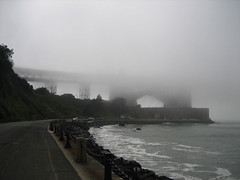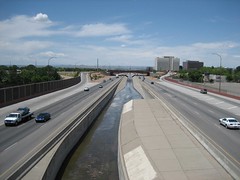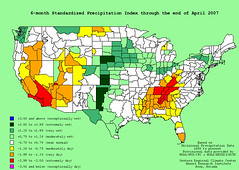Thanks to Luis ((Luis Villa)) and some guy named Simon ((Simon Elvery)), Inkstain is now footnote-enabled. Yay Simon!
Putting Porn (and a T-shirt) on the American Express
Postmodernism is a notoriously tricky thing to define. Standing on Fort Point, poking out into the Golden Gate, looking for the place where Kim Novak jumped into the water in Vertigo, trying to commit suicide (Or was she?), only to have Jimmy Stewart fish her out, is a clear enough example.
Or the plaque in Burritt Alley:
ON APPROXIMATELY THIS SPOT
MILES ARCHER.
PARTNER OF SAM SPADE,
WAS DONE IN BY
BRIGID O’SHAUGHNESSY
Or the House on Montgomery Street, down the Filbert steps from Coit Tower, where Humphrey Bogart shacked up with Lauren Bacall in Dark Passages. One of the people who lives there now has a life-sized cardboard cutout of Bogie in the window. He’s smoking what seems to be a postmodern cigarette. Continue reading ‘Putting Porn (and a T-shirt) on the American Express’ »
Albuquerque’s Water
Christie Chisholm has a great overview in this week’s Alibi of the city of Albuquerque’s San Juan-Chama water project. What I liked is the way she captured the complexity of this project. No easy answers, no free lunch when it comes to New Mexico water:
Even though the city wants to drastically cut pumping from the aquifer, the effects on the river will still be seen for many years. Also, as less groundwater is pumped, less water from the aquifer will be discharged to the river as municipal effluent, which is currently treated and sent downstream to irrigators like Robert. Over time, reduced pumping could help replenish the aquifer, but it will mean less water in the river for downstream users.
On My California Roots
Lissa and I are making a quick trip to California, which has me musing on my roots.
Joan Didion described those who created California as “not the self-satisfied, happy and content people, but the adventurous, the restless, and the daring.” I am anything but restless and daring (I hate moving across town), and I am no longer a Californian. But I can wax nostalgic.
On my mother’s side, I am second generation Californian, the child of a native. Her grandparents and parents helped with that strange frenetic (I was going to say “heroic” but didn’t) building of something from nothing that was the history of Southern California. I grew up in the literal shadow of old orange trees gone lemon. The oranges were grafted onto a lemon root stock, and when the grove came down and our house went up in the 1950s, the trees left as landscape architecture grew lemon branches from below. The town of my childhood was laid out as an “irrigation colony” by a Canadian born engineer named George Chaffey who laid out a grid of streets with a grand boulevard down its center and arranged for the irrigation water that brought forth citrus from the ground.
When I was young, we would visit our friends the Flemings, who still ran an orange grove, and on winter evenings everything would stop at 6 p.m. while Dick would listen to the fruit frost warnings on the radio. The Flemings lived in a grand old grove house (those beautiful grove houses were of a type). The last time I was out there, it was still standing, surrounded by tract homes, something new created from nothing where the something old (a grove) had been created from nothing still.
One could probably apply this line of thinking to any human built environment, any city, and see the something from nothingness of it, and it’s always a grand tale. But for personal reasons I am especially attached to the something from nothingness of my California ancestors. Los Angeles is a city that has no business being there. San Diego, San Francisco, Portland and Seattle all have ports. They all have a reason for being where they are. Los Angeles? It had no port, so they built one. The notion of an agricultural empire on the semi-arid coastal plain made no sense – until they brought the water. “There it is,” William Mulholland is said to have said as the first imported (stolen?) water came cascading down into the arid San Fernando Valley. “Take it.”
It’s at least of metaphorical relevance that the industry of make believe is called “Hollywood,” which is really just a made up place of only vaguely defined geographic identity – a sign on a mountainside (it originally read “HOLLYWOODLAND”) identifying a housing tract that hadn’t yet been built.
We’re going to San Francisco, which is California too, but quite different. They had a port and a gold rush and some intrinsic reasons for the place to exist. To Californians the distinctions between north and south make all the difference. If one is a Southern Californian, one still boos at the mention of Juan Marichal’s name. But from a distance I can see the chutzpah in San Francisco’s story too. There is something about the pressure of San Francisco’s geographic compactness that has created a very different version of the same story. They are Californians in ways my forebears were.
Dangerous Climate Interference
James Hansen and company have a new paper attempting to define “dangerous climate interference” and suggest where we currently stand relative to their chosen standard. Their answer? Close:
We examine potential criteria for dangerous climate change assuming that humanity wants to preserve planetary conditions similar to those in the period of civilization, thus near the range of climate in the present interglacial period, the Holocene, which has existed almost 12 000 years. Even with such an assumption, various uncertainties make definition of the dangerous level imprecise and imply that estimates must be continually refined as knowledge improves.
Nevertheless, we can conclude that the world is already close to the dangerous level. The sharpest criterion is probably maintenance of long-term sea level close to the present level, as about one billion people live within 25m elevation of today’s sea level.
There’s also a news release.
On the Mosquito and the Minnow
Mosquitoes feasted Tuesday morning on dignitaries who gathered in the Rio Grande bosque to commemorate the release of the millionth Rio Grande silvery minnow.
The minnow release was a celebration of efforts to save the fish from extinction. The mosquitoes were a reminder of an especially wet spring— nature cooperating with the minnow restoration effort.
It’s Melting
 New NASA data shows accelerated snowmelt in Greenland:
New NASA data shows accelerated snowmelt in Greenland:
To understand why these trends are important to track, Tedesco explained one of the consequences of melting snow. “Although wet and dry snow look similar at first glance, wet and re-frozen snow absorb more of the sun’s radiation, reflecting only 50-60 percent back into the atmosphere. Dry snow, on the other hand, reflects about 85 percent of the sun’s radiation,” he said. “In other words, melting snow absorbs three to four times as much energy as dry snow, greatly affecting Earth’s energy budget.”
Security in the Student Ghetto
Concerned by what I read in the comments on Duke City Fix, I dispatched Big Toe to Nora’s new neighborhood this afternoon to evaluate the security situation. Before he turned to science, BT trained with one of the famous Malaysian pirate ninjas, and he holds a black belt in Juhitsmo. Here he’s surveying the old Boo Radley house, which according to neighborhood lore has been home to some dastardly shenanigans.
I feel safer knowing BT is on the job protecting Nora.
Crosstown Traffic
I had a friend years ago in California, Victor, who was fun to talk to because he was so bafflingly smart. Among his many interests (he also imagined the Internet before there was one) was the way we map our personal geographies of the world around us.
I was thinking about Victor today as I took a shambling bike ride around Albuquerque.
When I started riding, an old-school roadie named Jim (they called him “the wedge,” a nickname that played up the cognitive dissonance between his apparent body type and his ability to ride) taught me some fine tricks for getting around, and for nostalgia’s sake I sought out some segments of Jim’s old routes.
Drought in the Southeast
Not exactly what you’d expect from an El Nino winter, when the typical pattern is to have wet anomalies across the southern tier of states in the continental U.S. and drier weather to the north.
As obsessed as I am with southwestern climate, if you judge by the news flow, the real action is in the southeastern U.S. Maybe it’s just that we westerners are more accustomed to aridity, so it’s less of a big deal. The important bit here is that drought is not a specific amount of water. It’s a lot less water than you’re used to. So if we’d gotten 17 inches (43 cm) of rain from Nov 1 through the end of April here in Albuquerque, our cactus would really be blooming. 17 inches in northern Alabama is at or near the driest on record. You can see the results in the latest round of headlines from around the region:





